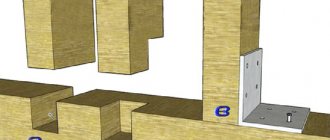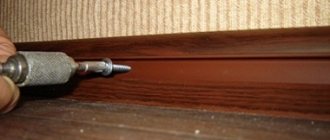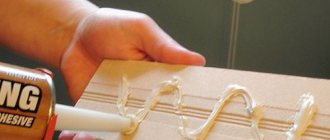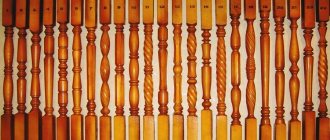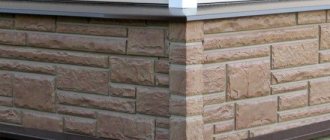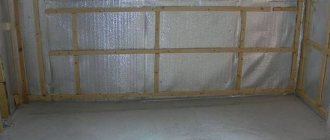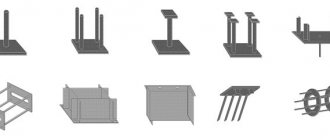Choosing the Right Hammer
A hammer is most often used for driving nails, in addition, it is used for removing old mortar from brick material, straightening sheet metal, and delicate work with tiles. They are distinguished by shape, weight, and the presence of metal, plastic, rubber or wooden elements. Because of this, choosing the right hammer is quite difficult, but it must be remembered that the incorrect choice or use of this tool can cause injury.
If you purchase a hammer with a metal spine, check its quality, take two identical hammers, and hit them against each other several times. If the product is of high quality, there will be no traces of impacts.
The handle must be firmly attached, have no cracks, and structurally consist of long fibers. There are plastic and metal handles, which, unlike their wooden counterparts, do not require maintenance.
The plastic handle with internal reinforcement is considered durable; the fastening of the working part does not weaken. The hammers, made entirely of metal, have rubberized handles that reduce vibration and make them comfortable to use. Such a tool has one main advantage - the integrity of the structure.
Instruments are also differentiated by weight. For household purposes, hammers weighing from 350 to 450 g are suitable; for more serious work, it is recommended to use a tool from 600 g.
Pull out with a metal comb
If the nail is small and does not sit very firmly in the wall, but does not wobble and pulling it out with your hands is not an option, then try using a regular metal comb. There are small gaps between the teeth. And if the thickness of the metal rod allows it to be inserted into this gap, then simply slide it all the way between them and pull it towards you.
The main thing here is to calculate the effort and not spoil a good thing. If the pin gives in, then good, but if the comb begins to bend too much, then it is better to put it aside and try other options.
Types of nails
There are dozens of types of this fastener. Nails are often considered the simplest fastening option, but their reliability and durability depend on proper handling. Experienced professionals use different types of nails of different sizes and with a variety of heads.
Here are the main types of nails:
- stainless steel – for boards;
- galvanized - for logs;
- brass or copper – used on concrete;
- plastic - they work with it on plasterboard sheets.
According to the head of the nails there are:
- with wide;
- with narrow;
- without her.
Fasteners are divided into the following types:
- construction;
- duquerte nails;
- screw or comb;
- anchor;
- nails for mesh or gypsum boards;
- hardened steel;
- for bitumen coatings;
- with double cap;
- comb on brick material.
Anchor nail
Pull with pliers
This option is suitable for firmly set nails. Pliers are a universal tool that has wide, flat “jaws” that can grab any small object well.
Also, many modern models of pliers have cutters similar to wire cutters. If the nail does not sit too deep, then first try to grab it with these cutters and press enough to fix it, but not to bite the nail itself.
Even the most unpleasant nail will succumb to this method, especially if you use the lever method. Where the cutters are useless or it is sunk too deeply, try to grab the cap with the jaws of the pliers and pull it towards you. More effort will be required, and the main thing here is to maintain balance and not fly too far with the pulled pin.
Nuances and techniques for working with different surfaces
It's time to talk in more detail about how to hammer nails correctly. At first glance, it seems that anyone can drive a nail into a wall. But here it all depends on what material you are trying to do this with. Ashamed of our own powerlessness, we stubbornly try to achieve our goal, often spoiling the surface of the wall and not finishing the job we started. To avoid such problems, you need to know how nails are driven into various materials correctly.
Brick wall
First, let's look at how to hammer a nail into a brick wall. All actions resemble a strict algorithm:
- select the place where you want to drive the nail. The central parts of the brick stone are best suited for this, since the mortar in the seams is not a very reliable support;
- a hole is drilled in the brick using an impact drill;
- a cartridge is inserted into which the nail is driven;
- All that remains is to restore order in the place where the work is performed.
Drywall
How to hammer a nail into a wall if it is made of plasterboard? To do this, perform the following steps:
- a hole is drilled at the intended point;
- a fastening element is inserted into it, a screw is screwed in;
- Remember that for such a wall it is extremely undesirable to use a nail as a fastener for heavy objects.
Tree
Let's look at how a nail is driven into wood. Note that the most convenient way to do this is to hold the nail at a slight angle. The resulting connection will have the greatest strength and will help fix the stubborn material together.
To drive a nail into wood, it is recommended to hold it at a slight angle
The technology of work is as follows:
- The board is placed in front of the marking, the nail is placed on the back side, driven in to a depth of approximately 5 - 6 mm, but not at an angle. The board is laid at a distance of 5 - 6 mm from the mark so that the nail is hammered in the required place;
- We bend the nail a little and fix it by hitting it with a hammer several times. The back of the board is supported with a finger during the hammering process to keep the angle under control;
- Nails are driven in at an angle on the other (opposite) side to complete the job and direct the board to the marked line.
Ceramic or tiles
Now imagine a wall covered with ceramic or tile material. How to hammer a dowel nail into it? To drive fasteners into such a surface, you will have to:
- visually mark the desired location. This could be a seam or the center of the tile;
- Using a metal screw, lightly tap on the surface of the glaze layer to create a depression;
- Drill a hole with a hammer drill;
- Having drilled the tile, we continue to work to the required depth;
- Insert the dowel into the prepared place and screw in the fastening element.
Concrete wall
The most difficult thing remains - how to hammer a nail into a concrete wall.
To do this, perform the following steps:
- the place where the nail needs to be hammered is outlined;
- Make a hole of the required depth using a hammer drill. It should be 5 mm longer than the length of the dowel;
- using a hammer, the cartridge is driven into the hole;
- a nail is driven in, but the required distance from the wall surface is maintained for hanging.
What tool is needed?
A very common mistake when hammering a nail is using the wrong hammer. It is worth remembering a simple rule that the larger and longer the nail, the larger and heavier the carpenter's hammer should be. Depending on the size of the nail, a specific hammer size is selected from four existing ones:
MST-1 with a handle of 25-28 cm, a working part of 9 cm and a weight of up to 250 g is good for driving the smallest nails up to 4 cm long;
- MST-2 with a handle of 30-32 cm, a working part of 11 cm and a weight of 500 g can be used for driving larger nails. This is the most popular tool;
- MST-3 already weighs 800 g, and in other parameters and scope of use it is almost no different from the previous version;
- MST-4 with a handle of 35-37 cm, a working part of 13 cm, and a weight of about 1 kg, hammers nails of 8 cm or more and even dowel nails.
Of course, with the help of MSP-4 you can hammer in a small wallpaper nail, but it will be more comfortable to work with a tool with adequate dimensions. But, if there is only one hammer in the house, and you need to hammer in a single nail to hang a picture, then there is no need to bother too much - it’s a different matter if the volume of construction work is larger.
Nuances and difficulties that arise when hammering nails
It is important to remember that moistened wood is much softer than dry wood. If you find it difficult to drive a nail without bending it, hold the body of the fastener using pliers.
Sometimes you have to deal with surfaces into which driving a nail is considered difficult or even impossible. In this case, a special tube or metal core should be used.
Sometimes there is a need to drive a nail that does not have a head. In order to perform this task effectively, it is necessary to observe the slope of the fasteners to the working surface, which should be up to ten degrees. They do not drive it in completely - leaving the top about three millimeters.
It is difficult to secure telephone wiring with nails. To cope with this task, you need to trim the wire and make sure that the nails do not damage the wires. After this, the wiring is pressed to the wall surface and nails are driven in. It is necessary to leave a free distance of one millimeter from the fastener head to the wall.
Rules for handling roofing nails
When fastening slate with nails, the head must completely seal the fastening hole so that moisture does not get into it. Violation of the fixing technology often causes leaks and sheets torn off by strong gusts of wind. To reliably fix the asbestos-cement coating on the surface of the slope, the following rules must be observed:
- Each sheet of slate is fixed to the sheathing with 10-20 fasteners. There is no point in saving slate nails, but their excess can also negatively affect the quality of the roof.
- Correctly drive nails strictly into the crest of the slate wave. Otherwise, the caps located in the gutters, where atmospheric moisture accumulates, will begin to corrode.
- First, nails are driven into the first and last ridge of the sheet, then into the middle and only after that into all the others.
- Do not drive nails closer than 15 cm from the edge of the asbestos cement sheet, so as not to split the roofing material.
- It is necessary to drive tar nails strictly vertically. If you break this rule, the fastening element will not create the necessary adhesion and will not close the hole in the slate, which will lead to leaks.
- To further waterproof the holes and protect the material from injury when struck with a hammer, you can drive nails through rubber gaskets.
- Do not drive slate nails all the way in so as not to accidentally split the fragile coating in order to compensate for the thermal expansion of the materials.
Experienced craftsmen note that asbestos cement can also be attached to the sheathing with self-tapping screws. They are made from hardened steel alloy, so they are stronger and more resistant to moisture. The disadvantage of this type of fastener is that during roofing repairs and dismantling, they are heavier and take longer to remove than roofing nails.
Nailing scheme
Sequence of nailing
Heat with a lighter
There is one interesting method that makes it easier to pull a nail out of its home. Everyone knows that when moving something heavy, the main thing is to move the object from its place, and then it becomes easier.
This principle also applies to solving our problem. Just take a lighter and heat the visible part of the nail. You need to warm it up thoroughly, then due to the high temperature, the material from which it is made will expand and squeeze the seat, thereby doing the work for you.
After cooling, it will no longer sit so tightly in the wall, and it will be easier to pull it out using any of the methods described in the article.
Can you drive a nail into drywall?
Before attempting to drive a nail into drywall, you need to consider whether the surface will be damaged. If you plan to hang some heavy object, then such material will not be the most reliable support. For small items, you can use a mount designed specifically for surfaces with low load-bearing capacity. To do this, you need to make a hole of a suitable diameter on the plane. The fastening element is inserted into the created gap until it stops. Then, by hand or using a screwdriver, tighten the screw.


